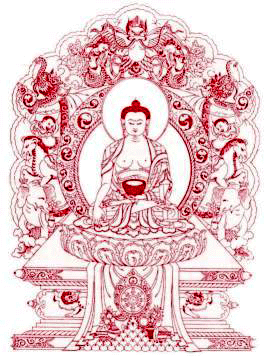 Being Here and Now is more than being in the present moment- it is the core of Buddhist philosophy. It is about leaving behind the reality created by the mind, and realizing the world as it is.
Being Here and Now is more than being in the present moment- it is the core of Buddhist philosophy. It is about leaving behind the reality created by the mind, and realizing the world as it is.
Enlarge Image The phrase “To Be Here and Now” has become part of our daily language. Usually when we use it, we mean to “become more present” and not to day dream. Most people know that the origin of this expression is Eastern and that Meditation Teachers often use it to increase the growth of awareness in our day to day lives.
Being Here Now is appropriate for any work that one does. It can be very critical if you are a doctor, a tailor, a driver, or a cook. You must pay one hundred percent attention if you want the food to taste good. In all schools, religions and philosophical paths few are the phrases upon which there is such common agreement.
Being Here, Now, penetrates through the whole philosophy of Buddhism. It goes straight to the core of the matter, the very essence of life and death. But when something becomes too common, the mystery it contains tends to weaken and die away.
Here and Now is more than becoming aware of the present moment. It is a difficult task. It requires one to take a very serious decision. One must make an important switch in the mind.
Each one of us lives in two different realities. One is the reality as it appears in front of us. It is reality as it is. The other is a parallel reality, one that exists only in our minds. The “Mind Reality” is an alternative to the real world. It is made up of a collection of ideas and thoughts, most of them directly related to sense excitement and feelings.
“Mind Reality” is divided into two sections – the one contains an “Idealistic” perfect world in which we would like to live. The second consists of everything which we conceive to be wrong with this world, as compared to our Ideal model. The first is based on our ideas of perfection, and the other is based on our skill of criticism, judgment and the pleasure of complaining. Concepts such as Good and Bad, Right and Wrong, Past and Future, expectations and disappointments, hopes, rules – all these are part of our idealistic and emotional world.
The heart of Dharma, as I have learned from Zen Master Nishijima, is that this confusion – between Reality as it is and reality as we perceive it through our mind or feel it through our senses – is the source of most people’s unhappiness.
Trying to put several realities together creates a constant and everlasting frustration. We face the problem that the real world is simply refusing to live up to our expectations. People insist on behaving and things insist on occurring in a different way than the way we expect them to.
Choosing “Here and Now” as a way of life means taking a brave conscious decision. It requires cutting down the energy supply to our imaginary, idealistic “Mind World”, as well as to our emotional world. It is the only way to deepen our roots to the real world of existence. In fact, this is the only way to reach the Truth.
It is a decision to drop dualism and give up our habit of holding parallel Realities that are made up of opposites, such as success and failure or ignorance and enlightenment. These terms exist only in the Mind, and are like a pair of thick and distorting glasses that we mistakenly consider as necessary.
As the imaginary, dualistic world fades away, one is left with reality itself. This truth is too powerful to resist. It enables one to be part of the facts instead of fighting them. It is the end of frustration that arises from the need to conform to two different worlds. It is the end of the habit of judging and the beginning of true acceptance, acceptance of others as well as of ourselves. When we let go of our own points of view, we receive the freedom to simply act from moment to moment, without the compulsion to constantly criticize everything.
Give the world the freedom to be as it is,
Give people the freedom to live and act as they wish,
And give yourself the freedom to have an opinion about everything.
Reality is wondrous,
Even if everything does not seem to be moral, righteous and perfect:
Not all homes are filled with love
Not all children get what they need
And not everyone is happy
But You can be moral, righteous and sensitive to other’s needs.
You can fill your house with love,
You can offer your children your clear mind.
Tao’s Center Homepage
By Nissim Amon




